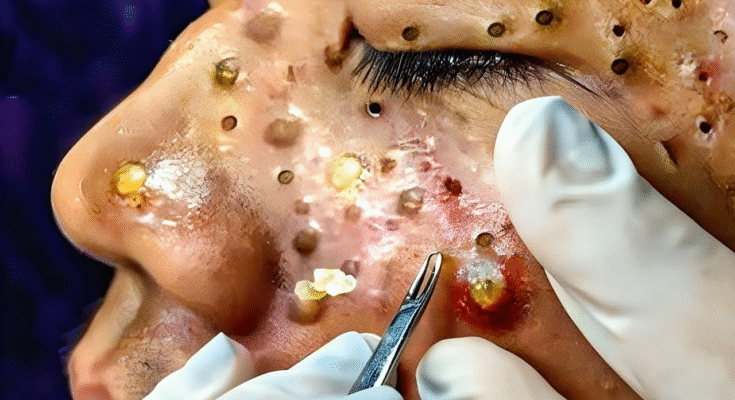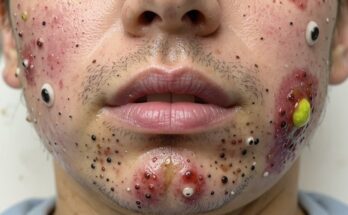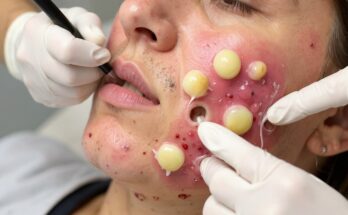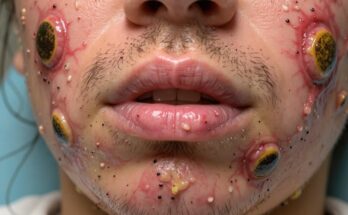Almost everyone has faced the temptation of popping a pimple. It feels like a quick fix — press it, squeeze it, and hope the problem disappears. But what many people don’t realize is that popping pimples does more harm than good. One of the most common and long-lasting consequences of squeezing blemishes is scarring. These scars can stay on the skin for months, years, or even permanently. But why does this happen? What is it about pimple popping that leads to marks and dents in the skin?
To understand the real reason popping pimples causes scars, you need to know how acne forms, how the skin heals, and why “helping it along” often backfires. Here’s a deeper look into what really happens beneath the surface.
1. Pimples Are Tiny Wounds — and Squeezing Makes Them Worse
A pimple isn’t just clogged oil. It’s a small wound filled with bacteria, inflammation, dead skin cells, and sebum. Your body is already working hard to heal that wound. When you squeeze it, you’re applying force from the outside, pushing pressure into the skin layers that are already inflamed.
Why this leads to scarring
-
Pressure causes the pore wall to tear.
-
This allows bacteria and oil to spill deeper into the skin.
-
The wound becomes larger and more severe than before.
Your skin sees this as major damage and responds with a strong healing reaction, which often results in either too much collagen or too little collagen — both of which form scars.
2. Popping Causes Deep Tissue Damage
Most people think that popping affects only the surface, but the real damage happens underneath. The moment you squeeze a pimple, the force travels down, not up. Instead of releasing the blockage outward, it often forces it deeper into the surrounding tissue.
This leads to:
-
Bigger inflammation
-
Swelling beneath the skin
-
Damage to deeper layers like the dermis
When deeper layers are injured, the skin struggles to heal smoothly. That’s why many pimple-popping scars look like dents, pits, or craters — the underlying structure has collapsed.
3. Internal Rupture Is the Biggest Cause of Indented Scars
One of the most harmful effects of squeezing is the internal rupture. This happens when the pressure causes the pimple to burst underneath the skin instead of on the surface.
What happens during an internal rupture
-
The infected material spreads into the lower layers of the skin.
-
Surrounding tissue becomes inflamed and damaged.
-
The deeper the inflammation, the higher the chance of scarring.
This is the exact mechanism that creates “ice pick,” “boxcar,” and “rolling” acne scars — the three most common types of indented scars.
4. Inflammation Determines How Severe the Scar Will Be
Inflammation is the skin’s natural response to fight bacteria and heal wounds. But when you pop a pimple, you drastically increase that inflammation.
Why more inflammation = more scarring
-
It disrupts healthy collagen production.
-
It slows down healing.
-
It makes the wound more vulnerable to infection.
If a pimple was mildly inflamed before, popping it can turn it into a deep red lump that stays for days or weeks — and eventually leaves a mark.
5. Your Skin Produces Too Much or Too Little Collagen
When the skin repairs itself, it relies on collagen, a protein that gives the skin structure. But squeezing disrupts this natural process.
Two ways this leads to scars
(1) Too little collagen → indented scars
When the skin cannot produce enough collagen to fill the damaged area, the surface sinks, resulting in:
-
Ice pick scars
-
Boxcar scars
-
Rolling scars
These are the most common scars after popping pimples.
(2) Too much collagen → raised scars
Less common but still possible, the body may overproduce collagen, leading to:
-
Hypertrophic scars
-
Keloids (especially on chest and jawline)
This explains why some people get thick, raised marks after picking or popping acne.
6. Bacteria Spreads and Worsens the Wound
Your fingers and nails carry bacteria even after washing. When you pop a pimple:
-
You push bacteria into the open wound.
-
New bacteria enters the broken skin.
-
Infection develops.
Infected pimples stay inflamed longer, which increases the risk of hyperpigmentation and scarring.
7. Popping Causes Post-Inflammatory Hyperpigmentation (Dark Marks)
Not all acne scars are dents. Many people develop dark marks after popping pimples — known as post-inflammatory hyperpigmentation (PIH).
Why it happens
When skin is injured, melanocytes (pigment cells) overproduce melanin. This leads to brown, red, or purple spots that can last months.
People with medium to deep skin tones experience this more frequently and more intensely.
8. Nails Create Micro-Tears in the Skin
Even if the pimple pops cleanly, fingernails often scratch or tear the skin. These micro-wounds take longer to heal and increase the risk of:
-
Infection
-
Inflammation
-
Scarring
-
Dark marks
Your nails act as tiny knives — especially when pressure is applied to delicate inflamed skin.
9. Some Pimples Are Not Meant to Be Popped
Deep, cystic, or nodular pimples don’t have a surface opening. They live under the skin. Trying to squeeze them will only rupture skin layers and cause major scarring.
These types of pimples require:
-
Warm compresses
-
Acne patches
-
Professional extraction
-
Dermatologist treatment
Trying to pop them guarantees long-term damage.
Final Thoughts
The real reason popping pimples causes scars is not just the act of squeezing — it’s the chain reaction it triggers beneath the skin. From tearing the pore wall and spreading bacteria to disrupting collagen production and increasing inflammation, popping turns a small problem into a much bigger one.
Instead of squeezing, the safest choice is to let pimples heal naturally or treat them with gentle methods like warm compresses, acne patches, and proper skincare. And if you truly need a pimple extracted, a trained professional can do it safely without harming your skin.



